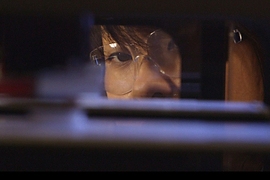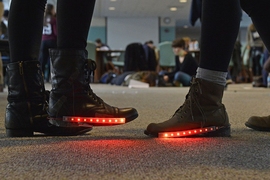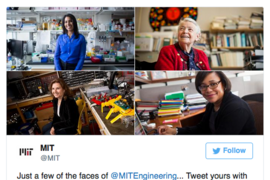Traditional photography classes highlight lessons about lighting and framing a photo, but instead of learning these techniques, 40 high school girls learned how to build a camera and how to write code for Instagram-like filters in a recent workshop.
On Saturday, June 4, these girls participated in the Girls Who Build Cameras workshop organized by MIT Lincoln Laboratory researchers at Beaver Works, just off MIT's main campus in Cambridge, Massachusetts. This one-day workshop taught girls how to build a Raspberry Pi camera and how to program image filters. Kristen Railey '13, a member of the technical staff in the Advanced Undersea Systems and Technology Group at the laboratory and the founder of a series of workshops called Girls Who Build, organized the event, which gathered more than 40 volunteers from Lincoln Laboratory, MIT, and various companies around Massachusetts to teach the students.
"Teaching girls engineering is an investment in our future workforce," Railey says. "Women are an untapped resource in the growing field of STEM [science, technology, engineering, and math]. The most effective way to spark a girl's interest in engineering is showing her how it is applied to her passion — whether it is fashion, health care, energy, or education."
Railey's idea to host a hands-on workshop based on cameras and programming filters came about because of the abundance of image-based social media apps such as Instagram and Snapchat that use filters to alter photos taken with smartphones. Cameras, Railey said, also require versatile engineering including optics, computer science, and mechanics, so the students could learn which field of engineering they may be most interested in pursuing.
In building the Raspberry Pi camera, the students were required to work in teams of four, and each team had a volunteer to guide them. Raspberry Pi is a series of credit card-sized single-board computers specifically designed for computer science education. Raspberry Pi, Inc. is a charity in the United Kingdom founded in 2009 to promote computer science education. The girls at the workshop used these single-board computers to build cameras of their own — only one girl had previously worked with Raspberry Pi. The students then programmed their cameras to produce several different image effects including flipping an image and using time lapse.
In the afternoon, the students were taught to use the programming language Processing to write code for image effects. As an introduction to the activity, a programmer who is from the data visualization company Fathom and who uses Processing spoke to the girls. During this coding process, the girls learned to program an Instagram-type filter to flip the image, create a vignette, tint the photo, or single out one color from the image. While learning how to code for these filters, the students learned programming concepts like loops (continually repeating sequence of instructions) and logic (learning to think like a computer by breaking down tasks into specific instructions) to help them write the code.
Volunteers from Lincoln Laboratory and other companies also spoke to the girls about their research involving cameras and image processing. Kristin Clark, a researcher from the Optical Engineering Group at Lincoln Laboratory, began the workshop by talking to the girls about her research in space cameras, most recently the Transiting Exoplanet Survey Satellite (TESS), a NASA-funded project aimed at discovering exoplanets, or planets that orbit stars outside of our solar system. Alex Lorman, chief of technology at Sea Machines Robotics, also explained the components of a camera and showed the students his professional photography equipment, including various lenses.
The program concluded with demonstrations at three stations to show the students how simple cameras can be applied to a variety of research areas. Jessica Johnson from Lincoln Laboratory's Space Systems Analysis and Test Group, displayed a light-field camera that captures the light density and direction in an image. Robert Schulein from the laboratory's Optical Communications Technology Group demonstrated photogrammetry — the use of photography to measure and map distances between objects. Tom Graves from DotProduct showed the students three-dimensional scanning with one of his company's products that employs a camera to capture a 3-D picture for use in verifying a building’s construction and in efficiently mapping underwater naval infrastructure.
The students were exposed to multiple scientific disciplines and with the hands-on activity were able to experience working in those fields as well. The keynote speaker, Uyanga Tsedev, a mechanical engineering graduate student at MIT, spoke about her research creating imaging probes for surgeons to identify tumors. The students also heard speakers from the Society of Women Engineers and the Women's Technology Program at MIT.
The Girls Who Build Cameras curriculum will soon be published on MIT Open CourseWare for educators and students everywhere. In the fall, Railey will work with staff at Lincoln Laboratory to jointly lead and advise the Girls Who Build initiative while she pursues a doctorate full time in the MIT/Woods Hole Oceanographic Institute Joint Program. "I believe a partnership with an MIT student organization would be incredibly beneficial to growing the program, with a larger volunteer base, more funding, and new perspectives for developing Girls Who Build curriculums," said Railey.
Before the workshop, half of the girls had never programmed before, and after, 90 percent said they wanted to continue learning to code. "This was a great experience for me because I had wanted to start programming," one of the students said, "but I didn't know how or where, and this was a great introduction."












